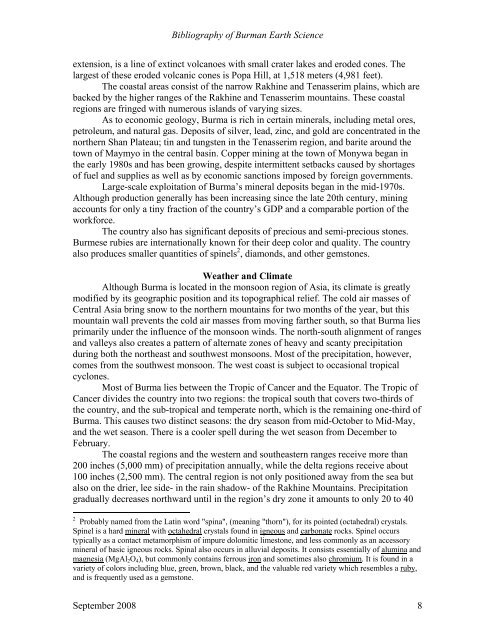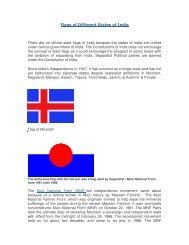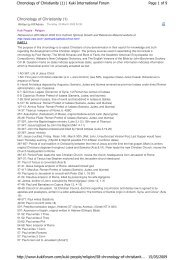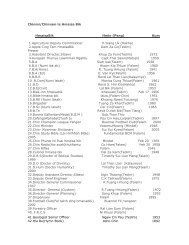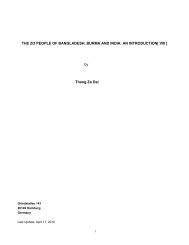The Geology of Burma - Zomi Online Library
The Geology of Burma - Zomi Online Library
The Geology of Burma - Zomi Online Library
You also want an ePaper? Increase the reach of your titles
YUMPU automatically turns print PDFs into web optimized ePapers that Google loves.
Bibliography <strong>of</strong> <strong>Burma</strong>n Earth Science<br />
extension, is a line <strong>of</strong> extinct volcanoes with small crater lakes and eroded cones. <strong>The</strong><br />
largest <strong>of</strong> these eroded volcanic cones is Popa Hill, at 1,518 meters (4,981 feet).<br />
<strong>The</strong> coastal areas consist <strong>of</strong> the narrow Rakhine and Tenasserim plains, which are<br />
backed by the higher ranges <strong>of</strong> the Rakhine and Tenasserim mountains. <strong>The</strong>se coastal<br />
regions are fringed with numerous islands <strong>of</strong> varying sizes.<br />
As to economic geology, <strong>Burma</strong> is rich in certain minerals, including metal ores,<br />
petroleum, and natural gas. Deposits <strong>of</strong> silver, lead, zinc, and gold are concentrated in the<br />
northern Shan Plateau; tin and tungsten in the Tenasserim region, and barite around the<br />
town <strong>of</strong> Maymyo in the central basin. Copper mining at the town <strong>of</strong> Monywa began in<br />
the early 1980s and has been growing, despite intermittent setbacks caused by shortages<br />
<strong>of</strong> fuel and supplies as well as by economic sanctions imposed by foreign governments.<br />
Large-scale exploitation <strong>of</strong> <strong>Burma</strong>’s mineral deposits began in the mid-1970s.<br />
Although production generally has been increasing since the late 20th century, mining<br />
accounts for only a tiny fraction <strong>of</strong> the country’s GDP and a comparable portion <strong>of</strong> the<br />
workforce.<br />
<strong>The</strong> country also has significant deposits <strong>of</strong> precious and semi-precious stones.<br />
Burmese rubies are internationally known for their deep color and quality. <strong>The</strong> country<br />
also produces smaller quantities <strong>of</strong> spinels 2 , diamonds, and other gemstones.<br />
Weather and Climate<br />
Although <strong>Burma</strong> is located in the monsoon region <strong>of</strong> Asia, its climate is greatly<br />
modified by its geographic position and its topographical relief. <strong>The</strong> cold air masses <strong>of</strong><br />
Central Asia bring snow to the northern mountains for two months <strong>of</strong> the year, but this<br />
mountain wall prevents the cold air masses from moving farther south, so that <strong>Burma</strong> lies<br />
primarily under the influence <strong>of</strong> the monsoon winds. <strong>The</strong> north-south alignment <strong>of</strong> ranges<br />
and valleys also creates a pattern <strong>of</strong> alternate zones <strong>of</strong> heavy and scanty precipitation<br />
during both the northeast and southwest monsoons. Most <strong>of</strong> the precipitation, however,<br />
comes from the southwest monsoon. <strong>The</strong> west coast is subject to occasional tropical<br />
cyclones.<br />
Most <strong>of</strong> <strong>Burma</strong> lies between the Tropic <strong>of</strong> Cancer and the Equator. <strong>The</strong> Tropic <strong>of</strong><br />
Cancer divides the country into two regions: the tropical south that covers two-thirds <strong>of</strong><br />
the country, and the sub-tropical and temperate north, which is the remaining one-third <strong>of</strong><br />
<strong>Burma</strong>. This causes two distinct seasons: the dry season from mid-October to Mid-May,<br />
and the wet season. <strong>The</strong>re is a cooler spell during the wet season from December to<br />
February.<br />
<strong>The</strong> coastal regions and the western and southeastern ranges receive more than<br />
200 inches (5,000 mm) <strong>of</strong> precipitation annually, while the delta regions receive about<br />
100 inches (2,500 mm). <strong>The</strong> central region is not only positioned away from the sea but<br />
also on the drier, lee side- in the rain shadow- <strong>of</strong> the Rakhine Mountains. Precipitation<br />
gradually decreases northward until in the region’s dry zone it amounts to only 20 to 40<br />
2 Probably named from the Latin word "spina", (meaning "thorn"), for its pointed (octahedral) crystals.<br />
Spinel is a hard mineral with octahedral crystals found in igneous and carbonate rocks. Spinel occurs<br />
typically as a contact metamorphism <strong>of</strong> impure dolomitic limestone, and less commonly as an accessory<br />
mineral <strong>of</strong> basic igneous rocks. Spinal also occurs in alluvial deposits. It consists essentially <strong>of</strong> alumina and<br />
magnesia (MgAl2O4), but commonly contains ferrous iron and sometimes also chromium. It is found in a<br />
variety <strong>of</strong> colors including blue, green, brown, black, and the valuable red variety which resembles a ruby,<br />
and is frequently used as a gemstone.<br />
September 2008 8


